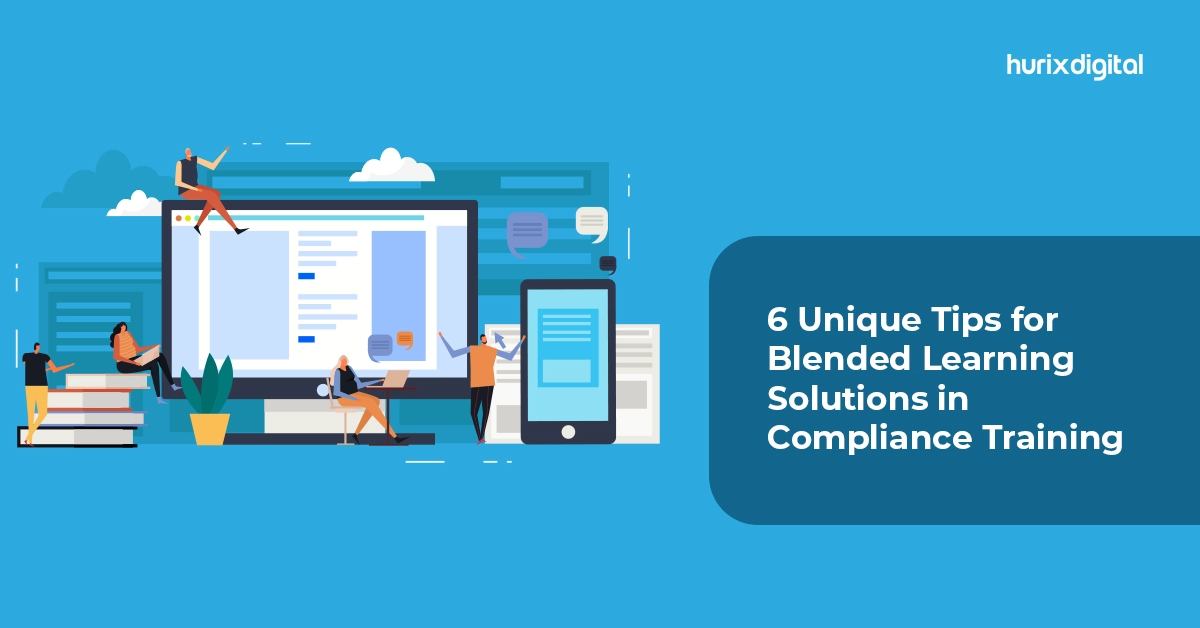Table of Contents:
- What is Blended Learning?
- What are the 7 Steps of Blended Learning Courses?
1. Define the Outcomes of the Course
2. Create an Outline for the Blended Learning Course
3. Determine the Level of Interactivity
4. Integrate Group Collaboration Activities
5. Facilitate Communication
6. Compile a List of Resources to Support Learning
7. Create an Assessment Plan - Conclusion
What is Blended Learning?
Blended learning courses are a training delivery method that blends together online resources and opportunities with traditional classroom-based teaching methods. While the learners attend classroom sessions with their peers and instructor, these face-to-face practices are enriched with online activity for content and delivery.
Blended learning offers the best of both worlds – on one hand, you benefit from a synchronous learning strategy, on the other hand, you also reap the fruits of asynchronous learning and learn at your own pace and convenience.
Many organizations are now leveraging digital resources to enrich their learning and development strategy without sacrificing the benefits of instructor-led classroom interactions. The question arises of how to create blended learning design courses that are engaging, interactive, immersive and flexible?
Here, in this blog post, we discuss steps to design effective blended learning course design.
What are the 7 Steps of Blended Learning Courses?
Let’s see how to create a blended learning course in a few simple steps:
1. Define the Outcomes of the Course
As with any learning strategy, the first step for designing blended learning courses is to define the objectives and goals you wish to achieve from your blended learning strategy.
The following questions can help you define your goals:
- What skills you wish to impart in your learners?
- What information should be included in the blended learning course?
- What instructional design models and instructional tools should be used to deliver new knowledge and information?
Your goals and objectives will serve as a roadmap to design your blended learning courses. At each step you will be able to see where your course is headed and the points you need to modify or cover along the way.
2. Create an Outline for the Blended Learning Course
A course outline offers benefits to all participants. The learners can use the outline to stay on track while the instructor/ course developer can use it to ensure that the blended learning course is progressing at the desired pace.
In your course outline, specify the course objectives, assignments, papers, and tests that have to be submitted, along with the deadlines that the learners have to meet. Also, clearly mention what you expect from the learners in terms of attendance and participation. And finally, also specify the instructional tools and material that will be used to deliver blended learning content.
3. Determine the Level of Interactivity
A major advantage of blended learning is it provides learners greater control over their learning. Learning is not just based on information imparted by the instructor, using both online and offline resources. Rather, learners can progress through self-paced learning activities.
When preparing your blended learning course design, determine the level of interactivity of your course. How much of the learning will be imparted in the classroom and how much will take place through live online media? How much of it will be self-learning through interactive activity?
When you opt for blended learning, you gain an opportunity to choose from a wide range of online learning resources and delivery methods.
For example, your learners can assemble in a classroom or some common place and an instructor based in some other city or country can deliver a lecture using an online environment.
In fact, the choices are many and you will have to spend some time in choosing one that is ideally suited to your blended course requirements. The best way forward is to assess your modules and then see what activities can be used to effectively communicate the core ideas.
Here are 5 Ways to Create Effective Interactive Training Content.
4. Integrate Group Collaboration Activities
While learning at your own pace has its advantages, the need for group collaboration cannot be overlooked. In team learning, learners gain an opportunity to interact with their peers, share knowledge and benefits from each other’s skill sets.
There are different online tools and applications that you can leverage to promote group activity. For example, your group can log into a chat room to discuss a particular problem. They can share their views, ideas, opinions and thoughts on social media platforms.
While designing an effective blended learning course, you should also create an effective social learning strategy to take learning out of the classroom and open conversations to a larger audience. These group interactions will also promote in your learners problem-solving, analyzing and rational thinking skills.
5. Facilitate Communication
Since blended learning involves online learning, ensure that your learners know how they can communicate with their instructor or facilitator in case they have a concern or query. For instance, they can expect a reply via email within 24 to 48 hours.
This is beneficial for the instructor and the learners: the instructor doesn’t have to be in the virtual classroom round the clock, and the learners also know that they have a solid support system they can turn to in case they face any problems.
Another factor to consider is how you will gather feedback from your learners – will you conduct periodic live chats or may be take surveys at the end of each blended learning course or module? It is very crucial that you seek regular feedback on your blended learning course to ensure it is moving on the right track and at the right speed.
6. Compile a List of Resources to Support Learning
With blended learning, you have the opportunity to choose from a wealth of resources to support your courses and provide these ready references to your learners. For instance, you may provide them links to articles, presentations, and videos to delve deeper into their lesson.
Your instructors too are spared the time needed for creating their own learning resources. They can spend their valuable time in more constructive interactions with your learners. So while designing your blended learning course, it is a good idea to create a list of resources and references that you will share with your learners.
7. Create an Assessment Plan
Your blended learning courses are incomplete if they don’t include an assessment plan to check the progress of the learners. Your assessment plan can include a quiz at the end of each module. Or they can be asked to summarize their learnings from a self-learning activity.
They may also be asked to participate in group discussion on chat forums. These assessments will not only help you gauge the progress of your learners but also give them an opportunity to pinpoint their areas for improvement. You could also provide a module summary at the end of each module to make it easy for them to recap the information.
Conclusion
Blended learning best practices are crucial for successfully navigating the evolving landscape of educational methodologies. In the realm of instructional design, it is essential to understand the nuances of blended learning vs traditional learning to make informed decisions. While blended learning is gaining prominence, it’s not just a buzzword; it represents a shift towards a more comprehensive and adaptive educational approach. Embracing blended learning best practices involves a strategic blend of online and traditional classroom methods, ensuring a harmonious integration of both.
To illustrate the versatility of this approach, consider these blended learning examples: incorporating e-learning modules alongside face-to-face interactions, using multimedia resources to enhance traditional lectures, or employing virtual simulations to complement hands-on activities. These instances showcase how educators can creatively apply blended learning best practices to cater to diverse learning styles. As you delve into the world of blended learning resources, remember that a well-rounded strategy encompasses not only technological tools but also pedagogical considerations. The effective use of digital platforms, interactive materials, and collaborative activities should align with established blended learning best practices.
Related:











